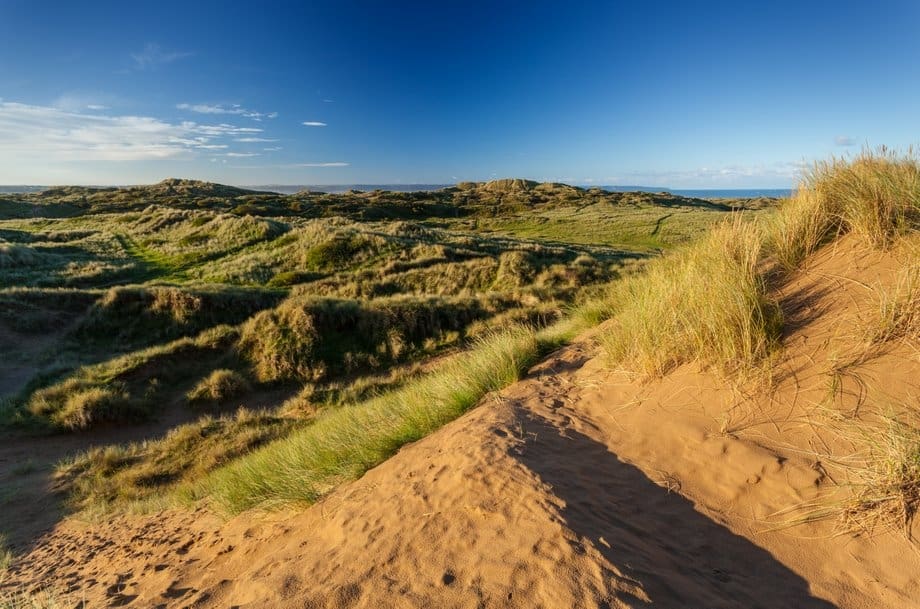Braunton Burrows is a natural reserve that spans an impressive 1,356.7 hectares, making it one of the largest sand dune systems in the UK. Located between Saunton Sands beach and surrounding farmland, this unique area is often regarded as the “jewel” of North Devon’s natural beauty. It is part of the UNESCO Biosphere Reserve, reflecting its global ecological importance.
Braunton Burrows offers visitors a unique opportunity to explore a landscape shaped by both nature and history. The dunes, which have evolved over thousands of years, host an array of plants and wildlife that are rarely found elsewhere in the UK. Whether you’re an avid birdwatcher, a casual walker, or a nature lover, Braunton Burrows provides a peaceful, pristine setting for exploration.
The Ecological Importance of Braunton Burrows
Rare Plant and Animal Species
Braunton Burrows is home to a wide range of rare plant species, making it an invaluable ecological site. Some of these plants, such as the water germander and sea stock, are protected due to their rarity. This site supports a unique combination of coastal flora that thrives in the dynamic sand dune environment.
In addition to its plant life, Braunton Burrows is home to an array of animal species, including rare moths, butterflies, and mollusks. These species have adapted to the ever-changing conditions of the dunes, where they find shelter and sustenance in the natural habitats. Braunton Burrows offers a sanctuary for these species, providing critical protection for biodiversity in an increasingly urbanized world.
Special Area of Conservation (SAC)
Braunton Burrows has been designated a Special Area of Conservation (SAC) due to its exceptional biodiversity. The SAC designation ensures that this vital natural space is protected by law, safeguarding the species that call it home and preventing any harmful development or activity that could damage its fragile ecosystem. The dunes and surrounding areas are meticulously managed to maintain their ecological integrity.
The conservation efforts in Braunton Burrows focus not only on plant and animal species but also on maintaining the landscape’s overall health. By preserving the integrity of the sand dunes and surrounding habitats, this area remains a critical refuge for species that might otherwise struggle to survive.
Geography and Location of Braunton Burrows
Size and Boundaries
Stretching over 1,356.7 hectares, Braunton Burrows is one of the most extensive sand dune systems in Europe. Its location along the North Devon coastline makes it particularly unique, as it is influenced by both the Atlantic Ocean and the surrounding rural landscape. The dunes are characterized by their rolling hills, tall grasses, and shifting sands, creating an ever-changing landscape.
The boundary of Braunton Burrows encompasses not just the dunes themselves but also the surrounding farmland, marshes, and wetland areas. This combination of habitats supports a rich variety of plant and animal life, contributing to the overall biodiversity of the region. Exploring the entire expanse gives visitors a chance to witness how different ecosystems coexist and thrive in harmony.
The Role of Saunton Sands Beach
Saunton Sands beach, located just to the south of Braunton Burrows, plays a crucial role in the reserve’s formation. The beach’s sandy shores provide a direct connection to the dunes, where the ever-shifting tides contribute to the formation of new dunes over time. This close relationship between the beach and dunes creates a dynamic ecosystem where both habitats support one another.
Saunton Sands also acts as the main access point for visitors, with walking trails that lead directly into the heart of Braunton Burrows. The beach provides stunning views of the dunes, making it an ideal location for photography, nature walks, and leisurely visits.
Braunton Burrows: A UNESCO Biosphere Reserve
History and Designation as a Biosphere Reserve
Braunton Burrows’ designation as a UNESCO Biosphere Reserve highlights its exceptional value for biodiversity and sustainable development. As part of the UNESCO World Network of Biosphere Reserves, it is recognized for its commitment to conservation, education, and sustainable land management practices. This prestigious designation ensures that Braunton Burrows receives the global attention it deserves, drawing visitors from around the world.
The area’s biodiversity, conservation efforts, and commitment to sustainability make it a vital part of the UNESCO Biosphere Reserve network. Its management focuses on striking a balance between protecting natural resources and supporting local communities and industries. This combination of efforts ensures that Braunton Burrows remains a living, thriving example of environmental stewardship.
The Role of Christie Estates and Land Management
Christie Estates, which manages much of the land in and around Braunton Burrows, plays a significant role in its conservation. The estate has worked closely with environmental organizations, local governments, and the public to ensure that the dunes remain protected from overdevelopment and erosion. Through sustainable land management practices, Christie Estates helps preserve the natural beauty and ecological importance of the Burrows.
These land management efforts are essential in keeping Braunton Burrows in its pristine condition. By carefully balancing human activity with ecological preservation, Christie Estates ensures that the natural landscape can continue to be enjoyed for generations to come.
Activities and Access: How to Explore Braunton Burrows
Walking Trails and Vehicle Tracks
Braunton Burrows offers a range of walking trails that allow visitors to explore its diverse landscapes. The trails are designed to be accessible, with well-maintained paths that weave through the dunes, offering stunning views of the surrounding area. Vehicle tracks also provide access to the reserve, allowing for a more in-depth exploration of the dunes.
Whether you’re an experienced hiker or someone looking for a leisurely stroll, Braunton Burrows provides options for all levels of ability. The paths are marked to ensure visitors stay on designated routes, minimizing the environmental impact on the delicate ecosystems.
Educational Programs and Conservation Efforts
Braunton Burrows is a hub for environmental education, with programs designed to teach visitors about the importance of conservation and sustainable practices. Guided tours, interpretive boards, and workshops provide insight into the reserve’s history, flora, and fauna, fostering a deeper appreciation for the environment.
The educational initiatives also help promote awareness of the challenges facing the dunes, such as erosion and habitat loss. By engaging with these programs, visitors can learn how they can contribute to the ongoing conservation efforts in the area.
Best Time to Visit
Braunton Burrows is a year-round destination, with each season offering a different experience. Spring and summer bring blooming flowers and abundant wildlife, while autumn and winter provide opportunities for birdwatching and quieter, peaceful walks. For the best experience, visitors are encouraged to check local schedules for any events or seasonal programs.
The Future of Braunton Burrows: Conservation Challenges
Sand Dune Erosion and Environmental Threats
Braunton Burrows faces several challenges, most notably sand dune erosion. Coastal erosion, exacerbated by climate change, threatens to degrade the dunes and their unique ecosystem. Additionally, human activity, including tourism and agricultural use, can lead to further strain on the landscape.
Conservation efforts are vital to combat these threats, and ongoing work is needed to protect the dunes from irreversible damage. Local conservation groups and governmental agencies continue to monitor the situation and implement measures to prevent further erosion.
Preservation Efforts and Local Initiatives
Various local initiatives focus on preserving Braunton Burrows, from volunteer programs to scientific research projects aimed at better understanding the ecosystem. By promoting sustainable practices and encouraging visitors to respect the environment, these efforts contribute to maintaining the integrity of the Burrows for future generations.
Conclusion: Why Braunton Burrows is Worth the Visit
Braunton Burrows is more than just a beautiful landscape; it is a vital natural resource and a testament to the power of conservation. With its rich biodiversity, educational programs, and unique coastal environment, it is an ideal destination for those seeking to connect with nature. Whether you’re visiting for a peaceful walk or to learn about the ecological challenges facing the dunes, Braunton Burrows offers something for everyone.
Frequently Asked Questions (FAQs)
- Why is Braunton Burrows so important to the UK’s natural environment?
Braunton Burrows is home to rare species and diverse ecosystems, making it essential for biodiversity conservation in the UK. - Can I visit Braunton Burrows year-round, or are there restrictions?
Braunton Burrows is open year-round, though certain areas may be inaccessible during extreme weather or conservation activities. - What rare species can I expect to see at Braunton Burrows?
Visitors may encounter rare plants like water germander and sea stock, as well as butterflies, moths, and mollusks. - Is there any entry fee to visit Braunton Burrows?
There is no entry fee, although donations for conservation efforts are encouraged. - What steps are being taken to protect Braunton Burrows from erosion?
Efforts include erosion control measures, sustainable land management, and community involvement in conservation programs.



